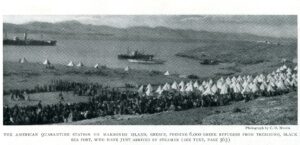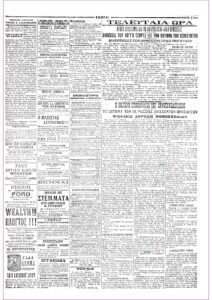The quarantine site of Makronisos
City
Migration Period
Category
Full Description
This is a photograph of the quarantine site that operated on Makronisos between 1922 and 1923. The photograph was part of a feature entitled ‘History’s Greatest Trek with 52 illustrations’ by Melville Chater, published in the magazine National Geographic, vol. xlvii, no 5, November 1925 (photographer C. D. Morris). The article extensively described the population exchange process and was accompanied by numerous photographs.
Makronisos is an uninhabited rocky island which stretches along the east coast of Attica. During and after the civil war, the island was used as a site for detainment camps and prisons for exiled soldiers, officers and citizens with ‘suspicious’ political beliefs. It was there that the state attempted to ‘reform’ the prisoners through a web of propaganda and violence, both physical and psychological.
However, Makronisos has another, lesser-known history as an isolation and exile site for enemies and outcasts. During the Balkan wars, it operated as an internment camp for thousands of Muslim prisoners of war, many of whom were transported there sick and at the point of exhaustion. The graves of hundreds of earlier prisoners were discovered in 1948 during the construction of the camp, according to the testimonies of the civil war exiles. The Muslim prisoners who had managed to survive were transported to Turkey in 1913.
Nine years later, Makronisos received refugees from Russia and Pontus. The refugees from Russia arrived in spring 1922 and were divided between the quarantine sites of Agios Georgios in Salamina and Makronisos. Over the following year (1922-1923) and particularly after Greece’s defeat in the Greco-Turkish war, thousands of refugees, mainly from Pontus, were taken to Makronisos, where they remained quarantined until they could be transferred. The tents of the encampment were arranged in zones according to the origins of the refugees and the disease ailing them, and sterilisation autoclaves were installed. From the end of 1922 onwards, the provision of food, housing and treatment to the refugees was undertaken by a charity organisation called American Women’s Hospitals which set up three makeshift hospitals, one for smallpox, one for typhus and one for non-transmissible diseases. However, despite their efforts, many refugees who had arrived in Makronisos already malnourished and debilitated never managed to leave the island.
The articles in the newspaper Empros from 23/6/1922 and 21/7/1922 shed light on the history of the first refugees from Russia, whose arrival had not been expected by the government of the time. The first article cites a discussion in parliament about the refugees taken to Agios Georgios in Salamina and how this was creating a health hazard in the area. The second article, entitled ‘The tragedy of Russian Greeks’, chronicles the movement of these populations and criticises the policy of inaction chosen by the Protopapadakis government. The article confirms the tragic conditions faced by the people arriving at Agios Georgios in Salamina: ‘As the necessary health measures of distancing, isolation, hygiene and proper diet were not implemented in time, about 1,200 out of 8,600 refugees have already died within 50 days of their arrival’.
Three more photographs of Makronisos in 1923 were discovered in the American Women’s Hospitals archive and are available in the iDEA repository, Libraries e-repository and archives of Drexel University in Philadelphia, USA. They are available here:
https://idea.library.drexel.edu/islandora/object/lca%3A8146#page/1/mode/1up
https://idea.library.drexel.edu/islandora/object/lca%3A8147#page/1/mode/1up
https://idea.library.drexel.edu/islandora/object/lca%3A8148#page/1/mode/1up
Bibliography
The Makronisos Digital Museum, ‘The island’s history before 1946’, https://www.makronissos.org/istoria-eos-to-1946/ .
Vlasis Agtzidis, ‘From Pontos to Makronisos’, kars1918.wordpress.com,https://kars1918.wordpress.com/2010/02/06/makronisos/
Bruce Clark, Twice a stranger. How mass expulsion forged modern Greece and Turkey, Harvard University Press, Harvard 2006.



